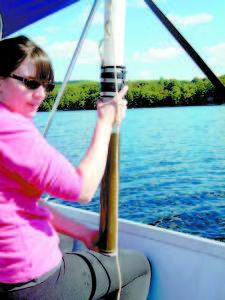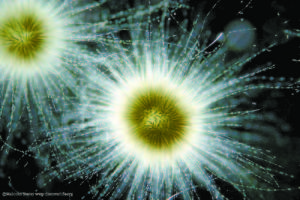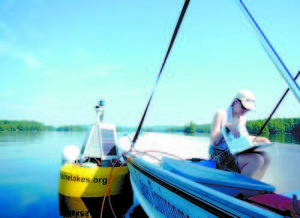LEA keeps close watch on water quality

Kelsey Boeff of the UMaine Climate Change Institute holds a deep sediment core. (Photo by Colin Holme)
By Leigh Macmillen Hayes
Special to The News
For more than 40 years, the Lakes Environmental Association has been monitoring the water quality of area lakes on a biweekly basis from May through October.
Regular testing from boats provides a general idea of a lake’s state of affairs at that given moment. From the information gleaned, LEA staff learns how much plant growth occurs in the water and the amount of nutrients available.
During a recent discussion, Assistant Director Colin Holme said, “With enough data, we can track changes. We’re starting to get enough now to filter through changes caused by the weather and understand cyclical patterns.â€
Though LEA continues to conduct these traditional tests because they provide a good assessment at regular intervals, lakes are far more complex. In recent years, it became apparent to Holme and LEA’s Executive Director Peter Lowell that there were other parameters yet to be examined.
Under the guidance of Holme and Researcher Amanda Pratt, advanced water quality tests have been added to the traditional testing techniques on 25 lakes in the region.
Pratt was hired a few years ago to analyze 15 lakes for Gloeotrichia, or “Gloeo,†a species of blue-green algae. Six of the 15 lakes showed increased concentrations of Gloeo.
Gloeo looks like tiny (1/16-inch diameter), round, yellow-green dots about the size of a pinhead and resembles pine pollen suspended throughout the water column.
This algae spends the early part of its life cycle on bottom sediments in shallow water where it absorbs the nutrient phosphorus. When conditions are right, it becomes buoyant and floats to the surface where it rapidly reproduces. This unique strategy helps it thrive in clear, low-nutrient lakes.
Gloeo testing has procured academic interest and larger lake associations like LEA are collaborating throughout New England to collect and examine data because scientists hypothesize that the presence of this algae in the water column is related to poor water quality.
Working with Dr. Holly Ewing of Bates College, who developed the sampling procedure Pratt uses, Gloeo appeared in seven of the 24 lakes tested in 2014. Keoka Lake displayed the highest level and elevated levels were discovered in Long Lake, Moose Pond, Crystal Lake, McWain Pond, Peabody Pond and Brandy Pond.
The identification of this algae in the Lake Region led to many questions including these: What other algae lurks in our lakes? And what does it mean to water quality?
Looking at what other organizations are doing about testing protocol, LEA decided that the next logical step was to have Pratt create a baseline snapshot of all algae present in our lakes. An expensive undertaking indeed, this included purchasing a high-powered microscope with monies from a Norcross Wildlife Foundation grant, and hours upon hours spent gathering, examining and categorizing algae from ten lakes.
Simultaneously, LEA staff learned about HOBO® data loggers from Dr. Dan Buckley of the University of Maine at Farmington. LEA attaches small digital temperature sensors every other meter from the top to the bottom and programs them to record readings every fifteen minutes. Upright buoys mark the location of the sensors, which create a temperature profile and determine fluctuations over time. Temperature controls the density of the water — lighter, warmer water sits on the top; denser, cooler water sinks.
While the traditional regime tests temperature at a particular time and day, the HOBO® sensors are installed in early spring and remain in the water until November. LEA then provides local lake associations that help fund this and other tests with an analysis of the data.
Progress in data collection doesn’t end there. With the receipt of a large grant from an anonymous foundation in 2014, LEA purchased a fully-automated hydrological GLEON buoy that you may have seen on Highland Lake.
GLEON stands for Global Lake Ecological Observatory Network. With lake-based monitoring devices, the buoy gathers temperature and oxygen readings every 15 minutes round the clock.
Temperature and oxygen structure are strongly tied to lake health. As Holme said, “All life needs oxygen.â€
Decaying organic material sinks to the bottom of a lake, thus using up the oxygen. Low oxygen or non-existent oxygen (anoxic) levels can be detrimental to fish and drinking water supplies.
The GLEON buoy has a fluorometer, another new device for LEA. This measures chlorophyll and phosphorus by shooting a light wave into the water column. It analyzes spectral reflectance and provides a calculation of the green pigment found in plants. The higher the chlorophyll, the higher the algae.
A solar-powered computer inside the buoy records all of the measurements and transmits them to the LEA office via a cell signal.
In addition, interns use a new hand-held fluorometer to test coves and other areas of the lake, thus creating an overall picture.
With the data from these varied tests, Holme and Pratt will create an assessment for Highland Lake, which can be compared to other lakes across New England and the globe.
Eventually, the data from the buoy will be available in a user-friendly form on LEA’s website: mainelakes.org
The last advanced initiative LEA has recently begun is sediment coring. In 2013, shallow sediment cores were taken from 25 of the 40 lakes in LEA’s jurisdiction.
The core mechanism is a specially designed pipe that is lowered into the sediment. A stopper that slips into place captures 6 to 8 inches of mud in the pipe. Of this, only the top one-inch of sediment and water gets analyzed.
The 2013 test indicated that five lakes had low amounts of aluminum in relation to the amount of iron. Pratt said, “That means if there’s low oxygen levels in those lakes, there is a greater risk that phosphorus will be released from the sediment.â€
“Overall, the test was reassuring,†said Holme. “Perhaps the reason why our lakes have traditionally been so clean.â€
In September 2014, the same anonymous foundation granted LEA funds to conduct deep sediment cores on Highland Lake and Long Lake in conjunction with the University of Maine’s Climate Change Institute.
Gathering a sample a couple of feet deep reveals 200 to 300 years of sediment build-up. About 25 centimeters of accumulated sediment was sectioned off and dated using lead-210.
By processing these samples, researchers at the Institute were able to determine when water quality changes occurred based on diatoms preserved in the sediment.
Pratt explained, “Diatoms are a type of algae with hard, silica-based shells, whose preferred environmental conditions differ depending on their species. Changes in the amount of diatoms indicate a shift in the water conditions at the time.â€
The study revealed Highland Lake changed in species composition in the 1950s. These changes were tied to shifts in water stability according to scientists at the University of Maine and likely a result of increased overall lake temperature.
While Highland Lake likely warmed since the ’50s, there were no changes in the nutrient level. Similar results were found for diatom abundance on Long Lake, but the change occurred about 1900. Around the 1950s, however, nutrient levels on Long Lake had increased.
All of this indicates that these lakes are experiencing longer periods of stratification or layering than they had in the distant past. The results do strengthen the argument that our lakes are warming.
What does all of this data mean for us as residents and visitors of the Lake Region? With informed test results, we can develop a better understanding of how lakes react to natural weather patterns as well as changes to the landscape and ecosystem caused by people.
“LEA’s testing program can aid us in understanding and diagnosing lake issues but ultimately, we will all have to look to the watershed and work together as a community to keep our lakes clean,†Holme said.
LEA hopes these initiatives are just the beginning of a dynamic way to keep people interested in local lake ecology. And this in turn will help everyone make informed decisions about how we all impact our surroundings.



